
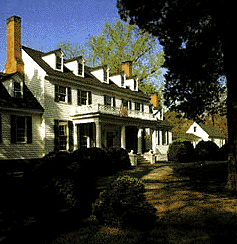
Sherwood Forest
Sherwood Forest has
the unusual history of being owned by two U. S. Presidents, with one actually
succeeding the other.
General William Henry Harrison inherited
the plantation in the late 18th century, but later sold it and moved to
Ohio. In 1840, he was elected the ninth president as a result of the famous
'log cabin campaign'. (See Assignment #8, 'The Rise of Democracy').
However, Harrison died in April, 1841,
just 30 days after assuming office. (Beginning in 1793, all presidents
were inaugurated on March 4 in the year following their election. In 1937
the date was moved to January 20.) Harrison's Vice-President, John
Tyler, became the first Vice President to assume the presidency upon Harrison's
death. Tyler bought Sherwood Forest a year later in 1842. It has
been continuously owned by his direct descendants ever since. In the mid-1970s,
the residence was restored by President Tyler's grandson and his wife,
the current owners.
Like Thomas Jefferson, Tyler was a
graduate of The College of William and Mary, and he later became Chancellor
of that institution. He was a member of the Virginia House of Delegates,
a Virginia state senator, twice Governor of Virginia, a member of the U.S.
House of Representatives and a U.S. Senator. In 1861 he was elected to
the Confederate Congress.
The House, built circa l730, is Virginia
Tidewater in architectural design, and is the longest frame dwelling in
America. It was expanded to its present length, 300 feet, by President
Tyler in 1845, when he added the 68-foot ballroom designed for dancing
the Virginia Reel.
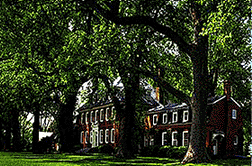
Westover
Westover was built circa 1730 by William
Byrd II, the founder of Richmond. It is noteworthy for its secret passages,
magnificent gardens, and architectural details.
Westover was named for Henry West,
fourth Lord Delaware and son of Thomas West, Governor of Virginia. The
shady tulip poplars framing the building are more than 150 years old.
The house is considered one of the
most outstanding example of Georgian architecture in America. Of special
notice is the unusual steepness of the roof, and the tall chimneys in pairs
at both ends. Another special touch is the elaborate doorway, which continues
to be recognized as "the Westover doorway" despite its adaptation to many
other buildings.
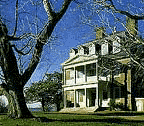
Shirley
Shirley Plantation was founded six years after
the settlers arrived at Jamestown in 1607 to establish the first permanent
English Colony in the New World. The plantation features the pineapple
(the Colonial symbol of hospitality) in the hand-carved woodwork in the
house, and as a three-foot finial on the peak of the roof. And for good
reason -- Shirley was a well-known center of hospitality in Colonial times.
The Hills and Carters entertained the Byrds
and Harrisons, not to mention Washington, Jefferson and other prominent
Virginians at Shirley. Visitors today see an 800-acre working plantation
operated by the tenth and eleventh generations of the Hills and Carters,
who continue this tradition of hospitality.
During the Revolution, Shirley was a supply
center for the Continental Army. A century later, during the Civil War,
Shirley survived the Peninsula Campaign and the struggle for nearby Richmond,
the Confederate capital. Anne Hill Carter, wife of Henry 'Light-Horse Harry'
Lee, of Stratford and mother of Gen. Robert E. Lee, was born at Shirley.
The famous Confederate general received part of his schooling in the converted
laundry house.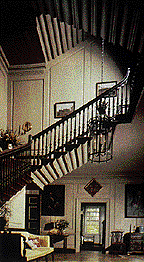 The present mansion was begun in 1723 by Edward
Hill III, a member of the house of Burgesses in the Virginia Colony, for
his daughter Elizabeth, who married John Carter, eldest son of King Carter.
It was finished in 1738 and is largely in its original state.
The home is recognized as an architectural treasure.
Its famous carved walnut staircase rises for three stories without visible
means of support, and is the only one of
its kind in America.
This historic estate provides an intimate study
of a way of life spanning three centuries. A visit to Shirley is a step
into American history. Shirley Plantation has been designated a National
Historic Landmark. No funds are received from any foundations or government
agencies. The entrance fees paid by visitors help to preserve and improve
this unique part of our heritage.
The present mansion was begun in 1723 by Edward
Hill III, a member of the house of Burgesses in the Virginia Colony, for
his daughter Elizabeth, who married John Carter, eldest son of King Carter.
It was finished in 1738 and is largely in its original state.
The home is recognized as an architectural treasure.
Its famous carved walnut staircase rises for three stories without visible
means of support, and is the only one of
its kind in America.
This historic estate provides an intimate study
of a way of life spanning three centuries. A visit to Shirley is a step
into American history. Shirley Plantation has been designated a National
Historic Landmark. No funds are received from any foundations or government
agencies. The entrance fees paid by visitors help to preserve and improve
this unique part of our heritage.
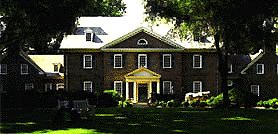
Evelynton
Evelynton was originally part of William
Byrd's expansive Westover Plantation. Named for Byrd's daughter, Evelyn,
this site has been home to the Ruffin family since 1847. The family patriarch,
Edmund Ruffin, fired the first shot of the Civil War at Fort Sumter. His
later agricultural contributions--from scientific soil testing to the publication
of The Farmer's Register--rescued l9th-century Virginia from a declining
agricultural economy, and earned him the title "father of American agronomy."
Evelynton was the site of fierce Civil
War skirmishes in 1862, when General George McClellan waged his destructive
Peninsula Campaign; J.E.B. Stuart, Stonewall Jackson and John Pelham bravely
led the Southern offensive in the Battle of Evelynton Heights.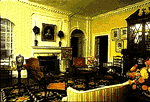 The original house and out-buildings
were burned during that conflict, and the current residence was erected
two generations later by Edmund Ruffin's great grandson, John Augustine
Ruffin, Jr. and his wife Mary Ball Saunders.Architect W. Duncan Lee, who
completed a brilliant restoration of Carters Grove in Williamsburg, designed
the Georgian Revival manor house in 1937. It is listed on the National
Register of Historic Places.
The original house and out-buildings
were burned during that conflict, and the current residence was erected
two generations later by Edmund Ruffin's great grandson, John Augustine
Ruffin, Jr. and his wife Mary Ball Saunders.Architect W. Duncan Lee, who
completed a brilliant restoration of Carters Grove in Williamsburg, designed
the Georgian Revival manor house in 1937. It is listed on the National
Register of Historic Places.
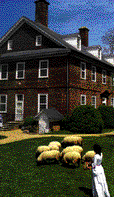
Berkeley
Benjamin Harrison, son of the builder
of Berkeley and the plantation's second owner, was a signer of the Declaration
of Independence and three-time Governor of Virginia. Benjamin's third son,William
Henry Harrison, was born at Berkeley, and later lived at Sherwood Forest.
The original mansion, built in 1726
of brick fired on the plantation, occupies a beautifully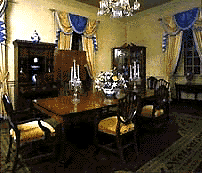 landscaped hilltop site overlooking the James River. Berkeley's ten acres
of formal terraced boxwood gardens and lawn extend a quarter-mile from
the front door to the river.
George Washington, and later the succeeding
nine Presidents of the United States, all enjoyed the famous hospitality
of Berkeley in this dining room with its view of the James.
landscaped hilltop site overlooking the James River. Berkeley's ten acres
of formal terraced boxwood gardens and lawn extend a quarter-mile from
the front door to the river.
George Washington, and later the succeeding
nine Presidents of the United States, all enjoyed the famous hospitality
of Berkeley in this dining room with its view of the James.
Answer the following questions
1. Identify the plantation home of both the ninth and tenth
presidents of the United States? Who were they? Which of these former
presidents later served in the Confederate congress?
2. George Washington and nine other presidents enjoyed the
dining room at this estate.
3. Identify the plantation home of a signer of the Declaration
of Independence. Who was he?

 Return
to Study Guide #1
Return
to Study Guide #1
 Revised
June 3, 2002
Revised
June 3, 2002
by Tom Gallup, e-mail address: [email protected]
West Valley College
http://www.westvalley.edu/wvc/ss/gallup/gallup.html









 landscaped hilltop site overlooking the James River. Berkeley's ten acres
of formal terraced boxwood gardens and lawn extend a quarter-mile from
the front door to the river.
landscaped hilltop site overlooking the James River. Berkeley's ten acres
of formal terraced boxwood gardens and lawn extend a quarter-mile from
the front door to the river.![]() Revised
June 3, 2002
Revised
June 3, 2002